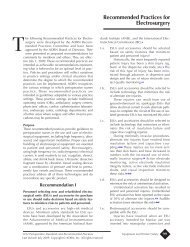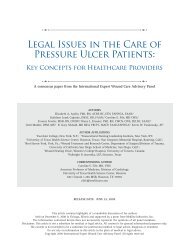Evidence Review Table 1B. What are the risk factors <strong>for</strong> <strong>CAUTI</strong>?1B.1. Following aseptic insertion of the urinary catheter, maintain a closed drainage system.(Category IB) a1B.2. Insert catheters only <strong>for</strong> appropriate indications, <strong>and</strong> leave in place only as long asneeded. (Category IB) b1B.3. Minimize urinary catheter use <strong>and</strong> duration of use in all patients, particularly those athigher risk <strong>for</strong> <strong>CAUTI</strong> such as women, the elderly, <strong>and</strong> patients with impaired immunity.(Category IB)1B.4. Ensure that only properly trained persons (e.g., hospital personnel, family members, orpatients themselves) who know the correct technique of aseptic catheter insertion <strong>and</strong>maintenance are given this responsibility. (Category IB)1B.5. Maintain unobstructed urine flow. (Category IB) ca More data are available under Question 2B.b More data are available under Question 2C.c More data are available under Question 2D.Q1C. What populations are at highest risk of mortality from urinary catheters?To answer this question, we reviewed the quality of evidence <strong>for</strong> those risk factors examined inmore than one study. The evidence <strong>for</strong> this question consists of 2 observational studies. 7,74 Thefindings of the evidence review <strong>and</strong> the grades <strong>for</strong> all important outcomes are shown inEvidence Review Table 1C.Low-quality evidence suggested that older age, higher severity of illness, <strong>and</strong> being on aninternal medicine service compared to a surgical service were independent risk factors <strong>for</strong>mortality in patients with indwelling urinary catheters. Both studies evaluating these risk factorsfound the highest risk of mortality in patients over 70 years of age. Low-quality evidence alsosuggested that <strong>CAUTI</strong> was a risk factor <strong>for</strong> mortality in patients with catheters.Evidence Review Table 1C. What populations are at highest risk of mortality fromcatheters?1C.1. Minimize urinary catheter use <strong>and</strong> duration in all patients, particularly those who may beat higher risk <strong>for</strong> mortality due to catheterization, such as the elderly <strong>and</strong> patients with severeillness. (Category IB)Q2. For those who may require urinary catheters, what are the bestpractices?36
To answer this question, we focused on four subquestions: A) What are the risks <strong>and</strong> benefitsassociated with different approaches to catheterization?, B) What are the risks <strong>and</strong> benefitsassociated with different types of catheters or collecting systems?, C) What are the risks <strong>and</strong>benefits associated with different catheter management techniques, <strong>and</strong> D) What are the risks<strong>and</strong> benefits associated with different systems interventions?Q2A. What are the risks <strong>and</strong> benefits associated with different approaches tocatheterization?The available data examined the following comparisons of different catheterization approaches:1) External versus indwelling urethral2) Intermittent versus indwelling urethral3) Intermittent versus suprapubic4) Suprapubic versus indwelling urethral5) Clean intermittent versus sterile intermittentFor all comparisons, we considered SUTI, bacteriuria/unspecified UTI, or combinations of theseoutcomes depending on availability, as well as other outcomes critical to weighing the risks <strong>and</strong>benefits of different catheterization approaches. The evidence <strong>for</strong> this question consists of 6systematic reviews, 37,104-108 16 RCTs, 62,63,109-122 <strong>and</strong> 18 observational studies. 54,73,81,84,123-136 Thefindings of the evidence review <strong>and</strong> the grades <strong>for</strong> all important outcomes are shown inEvidence Review Table 2AQ2A.1. External versus indwelling urethralLow-quality evidence suggested a benefit of using external catheters over indwelling urethralcatheters in male patients who require a urinary collection device but do not have an indication<strong>for</strong> an indwelling catheter such as urinary retention or bladder outlet obstruction. 81,109,123 Thiswas based on a decreased risk of a composite outcome of SUTI, bacteriuria, or death as well asincreased patient satisfaction with condom catheters. Differences were most pronounced in menwithout dementia. Statistically significant differences were not found or reported <strong>for</strong> theindividual <strong>CAUTI</strong> outcomes or death. Our search did not reveal data on differences in localcomplications such as skin maceration or phimosis.Q2A.2. Intermittent versus indwelling urethralLow-quality evidence suggested a benefit of using intermittent catheterization over indwellingurethral catheters in selected populations. 84,104-106,110-114,124-126,135,136 This was based on adecreased risk of SUTI <strong>and</strong> bacteriuria/unspecified UTI but an increased risk of urinary retentionin postoperative patients with intermittent catheterization. In one study, urinary retention <strong>and</strong>bladder distension were avoided by per<strong>for</strong>ming catheterization at regular intervals (every 6-8hrs) until return of voiding. Studies of patients with neurogenic bladder most consistently found adecreased risk of <strong>CAUTI</strong> with intermittent catheterization. Studies in operative patients whosecatheters were removed within 24 hrs of surgery found no differences in bacteriuria withintermittent vs. indwelling catheterization, while studies where catheters were left in <strong>for</strong> longerdurations had mixed results. Our search did not reveal data on differences in patientsatisfaction.Q2A.3. Intermittent versus suprapubic37
- Page 4 and 5: AcknowledgementHICPAC thanks the fo
- Page 6 and 7: AbbreviationsADLAPACHE IIASAASBBUNC
- Page 8 and 9: I. Executive SummaryThis guideline
- Page 10 and 11: II. Summary of RecommendationsTable
- Page 12 and 13: II. Proper Techniques for Urinary C
- Page 14 and 15: 1. If obstruction is anticipated, c
- Page 16 and 17: a. Procedure-specific guidelines fo
- Page 18 and 19: III. Implementation and AuditPriori
- Page 20 and 21: IV. Recommendations for Further Res
- Page 22 and 23: V. BackgroundUrinary tract infectio
- Page 24 and 25: acteriuria inevitably occurs over t
- Page 26 and 27: VII. MethodsThis guideline was base
- Page 28 and 29: Figure 2: Results of the Study Sele
- Page 30 and 31: After determining the GRADE of the
- Page 32 and 33: Category I recommendations are defi
- Page 34 and 35: VIII. Evidence ReviewQ1. Who should
- Page 38 and 39: Very low-quality evidence suggested
- Page 40 and 41: Q2B.2. Hydrophilic catheters vs. st
- Page 42 and 43: For all comparisons, we considered
- Page 44 and 45: a. Clamping vs. free drainage prior
- Page 46 and 47: studies. 3,25,260-276 The findings
- Page 48 and 49: 2D.5. Maintain unobstructed urine f
- Page 50 and 51: 15. Jain P, Parada JP, David A, Smi
- Page 52 and 53: 44. Chaudhuri P, Vengadasalam D. Ur
- Page 54 and 55: 71. Kelleher RE, Meeropol E, Parks
- Page 56 and 57: 101. Hirsh DD, Fainstein V, Musher
- Page 58 and 59: 132. Van Nagell, JR, Penny RM, Rodd
- Page 60 and 61: 163. Lai KK, Fontecchio SA, Lai KK,
- Page 62 and 63: 193. Waites KB, Canupp KC, Armstron
- Page 64 and 65: 222. Cohen A. A microbiological com
- Page 66 and 67: 253. Chavigny KH. The use of polymi
















